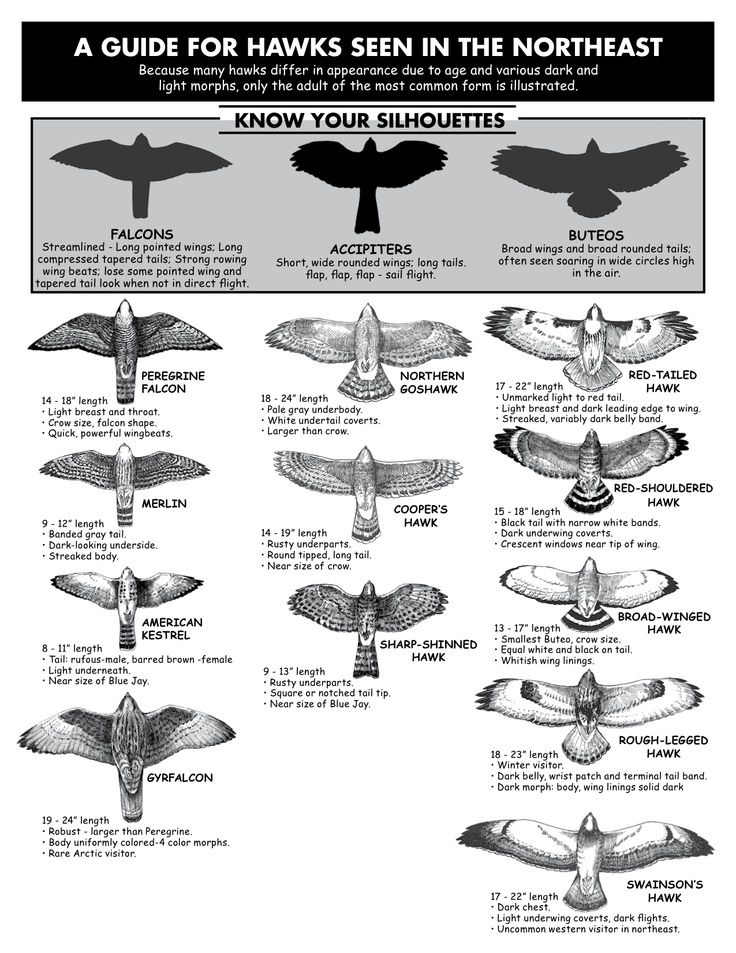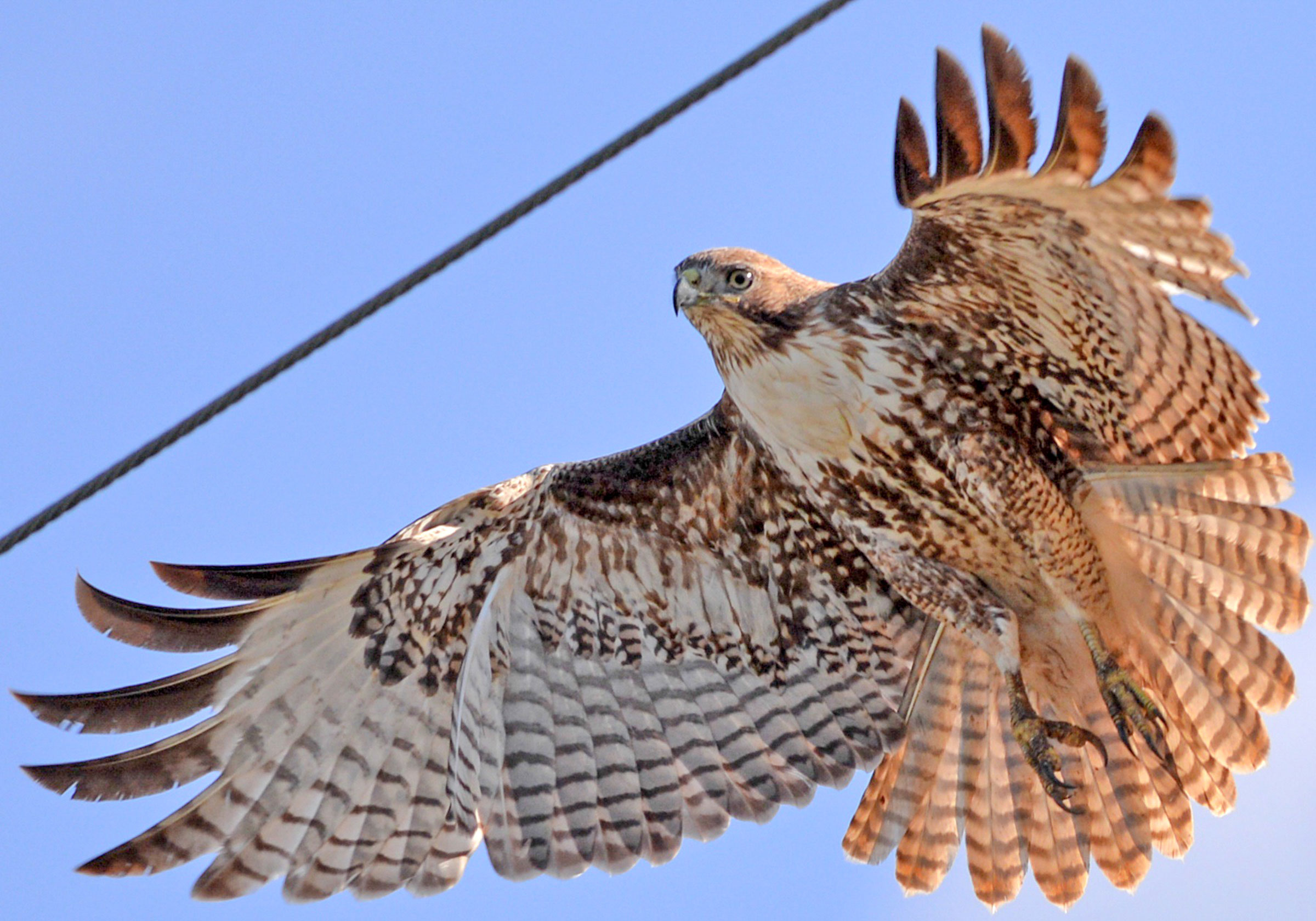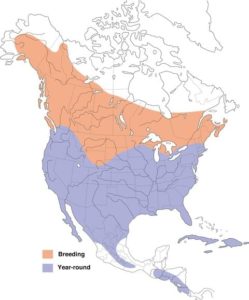By Executive Director Heather Good
While I appreciate birds individually and in and of their own right, beauty, ecology, and behavior, birds of prey were one of my early comfort zones in terms of learning bird ID skills.
It’s not that I was a kind of raptor Rain Man, coming close to any semblance of memorization or mastery as far as raptors were concerned. It was, however, comfortable for me to try to learn about hawks in particular: the bands, the blending-in, the soaring, the strategizing. The way they’d perch for what seemed like an eternity in places I didn’t expect to find them. I felt comfortable and drawn into observing them. Growing up in Metro Detroit certainly helped hook me on hawks in particular, owing many thanks to the Red-tailed Hawk’s ability to adapt like a boss.
Red-tailed Hawks are, in fact, the most common North American hawk, so they aren’t at all considered threatened — not technically.
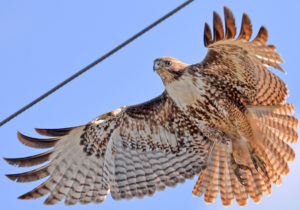
Red-tailed Hawk. Photo: Lorna Padden/Audubon Photography Awards
In reality, hawks face more threats to their health and survival than ever, especially being as widely-distributed as some species are in urban and rural environments alike. These ever-increasing threats that concern us range from collisions with vehicles and buildings, lead poisoning, rodenticide use, wind turbines, habitat loss and fragmentation, and lack of ample funding, research, policy, and protection from the Federal Government for our vulnerable avian food-chain toppers.
Wind farms are now being referred to in avian conservation studies and articles as “the new apex predators” because of raptor mortalities. The very same wind thermals that hawks use tend to be right where wind turbines are placed — and they’re placed there for a reason (migration knows best, right?).
To me, the joy of appreciating birds bears with it the privilege and responsibility to share and protect them. After all, the work we must do to protect birds — even, yes, the ever-abundant Red-tailed Hawk — is everywhere.
Staying Connected Through Hawkwatching
There is a lot to take in right now, the threats to birds, wildlife, people, and the planet — our fears, our coping mechanisms attempting to adapt half as well as that famous Red-tailed Hawk pair in Central Park.
Still, we can learn from them. We can benefit from them. We can help them. We can enjoy them. We can, as I heard once in a preschool setting, “fill our cup” by watching them.
And we do. We’ve seen through this pandemic many articles in the media and on social sites to this effect: more people are, in fact, watching birds.
Seeing that daily bread Red-tailed or Cooper’s Hawk for me in the Detroit area is part of what keeps me feeling connected, no matter how the world around me may feel.
Several species of hawks are a staple sight for Michigan residents and visitors, whether those people see, know, and appreciate the bodacious buteos that stoically line our roadways and soar through our skies or not.
You could be at a strip mall, a local playground, a nature preserve, or a red light and a species of hawk could grace you. I think that counts for something, especially now when our individual worlds can feel a bit on the small side due to the pandemic.
For me, Red-tailed and Cooper’s Hawks — because of how frequently I spot them — are regular reminders that the opportunity to learn, connect with, and share the world of birds is everywhere.
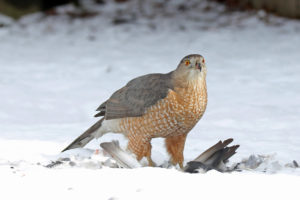
Adult Cooper’s Hawk. Photo by Pamela Kopenapa, Audubon Photography Awards.
Because they often ambush and dive-bomb their prey, hawks feeding is a demonstration of major avian strategy, skill, and speed. It’s that vision, 2–3 times better than ours, and those ever-observable smarts that really hooked me as a kid. Later, when I learned about the Harris’s Hawk, and was able to work with one as an environmental educator, I was all the more transfixed. I still haven’t made it to view them in the Southwest for their group hunting strategy in real time, but that is on my bucket list.
In southeast Michigan though, I do see a number of my favorite hawk, which happens to have a very similar range to the Red-tailed: the Cooper’s Hawk.
One fall afternoon nearly 10 years ago, I was rocking my daughter in the living room, watching Northern Cardinals, Mourning Doves, and American Goldfinches pick away at sunflower chips and thistle seeds at the feeders out front. It was one of those peaceful Sunday stretches of afternoon: quiet, still, and perfect for birdwatching. I was watching a Mourning Dove take up a majority of the space in a platform feeder when suddenly, a mass of feathers and talons collided at my front window with a zen-breaking thud. My infant’s body jolted awake and I started toward the front door to investigate with her in tow (start them young, right?).
There, in the privacy of the front hedges, a large female Cooper’s Hawk was using her sharp, hooked bill to tear into this just-won prey (it was that space-hogging Mourning Dove). The hawk looked up at me nonchalantly, a kind of do you mind, turning back after a moment to her purpose, this masterful carnivorous lunch.
Clever girl, I thought to myself (as Muldoon says to the raptor who outwits him in the movie Jurassic Park).
Relieved that this was likely more of a strategic collision than an actual issue related to window glare potentially confusing birds, I chalked this up to another adventurous sighting in backyard birding and continued with my day. The feeders, full of seed, swayed with vacancy for a good half hour after she made her strike.
A few days later, I noticed two Cooper’s Hawk perched somewhat secretively, absolutely still, in the walnut tree across the street. One was, as my friend Diana would say, “a big lady bird,” and the male, a sleek, ever-alert little bullet of an accipiter.
They were quite the pair to behold, casting a most intense and strategic gaze on my feeders.
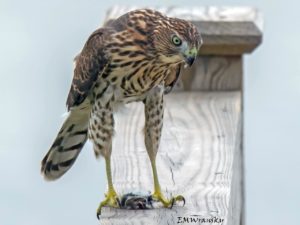
Juvenile Cooper’s Hawk. Photo by Ed Wranksy.
This is my kind of birding: witnessing birds everywhere, anywhere. Taking notice. Taking pause. And when I can, how I can, as much as I can — taking part in helping them, their world, our world.
Oh — and the Mourning Dove body slam move into the front window happened two more successful times that week. Then, oddly, I never observed it again.
Fall Hawkwatching in Michigan
As raptors migrate in the fall toward wintering grounds and in the spring toward their nesting territory, covering thousands of miles within a matter of weeks, they create incredible viewing opportunities for us in the Great Lakes State. If you are new to hawkwatching, the Hawk Migration Association of North America (HMANA) has a great page called just that: New to Hawkwatching?.
Really great hawkwatching sites are often utilized for conducting hawk counts — a mainly community-science-driven activity where typically, experienced volunteers count migratory raptors to gather data related to their migration. HawkWatch International’s short video not only showcases their work with raptor avian footage, but it also serves as a great introduction to hawkwatching as a collaborative, international conservation effort.
With migration patterns differing between spring and fall, many hawk watch sites only conduct research during a single (spring or fall) season. Whitefish Point Bird Observatory and Brockway Mountain Hawk Watch are prime spring migration sites but not so for the fall season, for example. Those lucky devils at the Mackinac Straits Raptor Watch (MSRW) see great migration numbers in both migration seasons and conduct their hawk counts twice a year (the location of the counts are different but near each other).
The convergence of Lakes Michigan and Huron tend to funnel migrants flying south over the Straits of Mackinac each fall in Michigan. The MSRW’s counters and volunteers provide consistent monitoring of important raptors, particularly hawks and owls. According to their website, “Because of its geography, the Straits is one of the best places in the country for studying raptors in both the spring and fall migration seasons.” In the fall, the MSRW conducts its raptor watch north of the bridge from Point LaBarbe. For details on the specific sites and maps of this hawk watch location, click here.

The Detroit River Hawk Watch at Lake Erie Metropark. Photo by Kevin Arnold, Southern District Interpretive Services Supervisor.
Fall Hawk Watch Spotlight: Detroit River Hawk Watch
Each fall, for over 35 years, the Detroit River Hawk Watch is conducted Sept. 1–Nov. 30 at Lake Erie Metropark in Brownstown, Michigan.
I mentioned growing up in Detroit. Well, the Detroit River Hawk Watch site is pretty much the wonderful world of Oz for a budding birder/hawkwatcher, so whether it’s you yourself, you and a young person you want to share birds with, or with/for someone you know who maybe doesn’t feel as comfortable, safe, or invited to the birding table, or is brand new to it, I encourage you to discover the Detroit River Hawk Watch.
Due to COVID-19, while the Metropark is currently open to the public, for the safety of their counters and volunteers, our friends at the Detroit River Hawk Watch “encourage visitors to follow along with the count virtually on HawkCount.org, or our Detroit River Hawk Watch Facebook page. There will be daily updates and photographs. If you do decide to join us in person, please help the counter and volunteers to follow their mandated safety protocols by refraining from approaching them. Please follow the recommended COVID-19 procedures by wearing a mask and maintaining a safe social distance. Thanking you in advance for your cooperation. Stay safe!”
HMANA Offers Free, Virtual Lunch & Learn Series This October:
Live from the Detroit River Hawk Watch
Thursday, October 15, 2020 | 12–1 p.m. EST
Josh Haas, veteran hawkwatcher and photographer, will broadcast LIVE from the Detroit River Hawk Watch site. This is an incredible chance to virtually visit the hawk count site and to learn all about what we’re seeing, the counters, volunteers, and what’s happening over Lake Erie that day. Mark your calendar and spread the word!
Join us then and there on Facebook LIVE (HMANA’s page).
Hawkwatching during a pandemic: if you are considering visiting a hawk watch site this fall, please first read HMANA’s Top Ten Guidelines for Visiting a Hawk Watch in Autumn 2020.
The Mackinac Straits Raptor Watch (MSRW)
The convergence of Lakes Michigan and Huron tend to funnel migrants to fly south over the Straits of Mackinac every fall in Michigan. The MSRW’s counters and volunteers provide consistent monitoring of important birds, such as hawks and owls, during fall migration. According to their website, “Because of its geography, the Straits is one of the best places in the country for studying raptors in both the spring and fall migration seasons.”
Fall Raptor Watch at MSRW
In the fall, MSRW conducts its raptor watch north of the bridge from Point LaBarbe. For details on the location of the fall raptor watch, click here.
Helping Hawks
-
- Learn about them, enjoy them, love them, and talk about what you think, see, and know. The education and passion of someone knowledgeable about hawks is contagious and it does, ultimately, help us protect birds.
- Friends don’t let friends use rat or mouse poison or pesticides.
- Just say no to rodenticide!
- Get involved with your local community government or township in terms of alternative energy plans/developments, lighting ordinances, new construction proposals, etc. Individuals can make a real difference for birds by exercising their voice, talents, and votes. Many wind energy developments are determined by townships, so local, grassroots organizing help on this front is always needed for birds!
- If you find an injured hawk:
- Assess with this flow chart.
- Call the closest raptor rehabber on the Michigan Licensed Rehabilitators webpage for assistance.
- Report a sick, dead, or dying hawk (or other bird):
- Use the Wildlife Disease Laboratory’s webform or call the disease lab at 517-336-5030 to report. Monitoring wildlife disease and mortality is an important part of wildlife management, so your observations really do help.
- If you see anyone harming or trying to harm or kill a bird:
- Call or text 800-292-7800 24 hours a day, 7 days a week *or*
- Complete this reporting form on the Michigan DNR website.
- Hawks are protected by the Migratory Bird Treaty Act. Since some consider them a nuisance due to their taste for poultry, for example, some hawks are threatened or killed illegally.
- Join your local Michigan Audubon chapter (or just write to us at birds@michiganaudubon.org; we’ll help you find a local group!). Not only do our chapters provide fellowship among bird lovers, but they also provide opportunities for continued education through speaker series, workshops, and author visits that can continue to keep you engaged and inspired.
- Find a HawkCount near you.
- Connect, ask questions, and explore all that Michigan has to offer for hawkwatching!
Hawks Hunting Feeder Birds — Should I Be Worried?
Let’s call a spade a spade — or, rather, a bird feeder a bird feeder. That’s what these “backyard hawks” — smaller-sized hawks such as Cooper’s and Sharp-shinned — think when they see the small birds displayed at our feeders: a bird feeder!
So, no need to panic: everything needs to eat. Here are a few recommendations if you have bird feeders that will keep them from becoming unfair deathtraps to smaller birds:
- Try taking your feeders down (sometimes for a few days, maybe up to a week) if you notice hawks picking off your visitors for midday snacks. The hawks will soon move on to better hunting grounds — they’re called master-adapters for a reason!
- Keep in mind that hawks feeding at these stations do often go for the weak, sick, or dying individuals, so there is often an important food chain function at work here, too.
- If you’d like to increase the overall well-being of songbirds in your yard, think less lawn, more native plants. That mantra does most neighborhoods a whole lot of long-lasting good. Enhancing habitat for birds creates a more appropriate ecological space for them to thrive.
- Create more cover with brush piles. They’re mysterious, interesting, action-packed, and more functional than you think!
Field Guides & Other Hawk-Related Resources
The Crossley ID Guide: Raptors by Richard Crossley, Jerry Liguori, and Brian L. Sullivan, Princeton University Press (2013)
Hawks in Flight by Pete Dunne, David Sibley, and Clay Sutton, Houghton Mifflin (2012)
Hawks at a Distance: Identification of Migrant Raptors by Jerry Liguori foreword by Pete Dunne, Princeton University Press (2011)
My 9-year-old prefers Stan Tekila’s Birds of Prey of the Midwest Field Guide (2010), not only for its ease of handling and less-intimidating size for a young birder, but also because it focuses on hawks, eagles, falcons, kites, vultures, and owls of the Midwest. An ID source that is regional or state-specific is a great tool for kids to learn more about ecology and to deepen their understanding of Michigan ecosystems.
As far as field guides go, it’s ultimately to each her own, as it goes. Favorite field guides are a very individual process and product, my experience has told me. It’s all about the trial-and-error, the getting out there, and the asking questions. You’ll find that the hawk watch site counters are often (fittingly) busy with the massive task of counting during their shifts, but the volunteers who assist at hawk watch sites are there largely to serve as outreach, education, and engagement support to visitors. They are like magical hawk watch docents, almost always patient and willing to educate even the newest to the birding world. Actually, ’ve found hawk watch sites to be some of the most gregarious in terms of offering education, insight, stories, and the sheer passion that drives these folks to stare into the sun for science for hours on end.
Thank you, whether you are a paid counter or a volunteer counter or someone serving on the board of directors as a volunteer, it takes a village — an international village, really — to understand and support hawks.
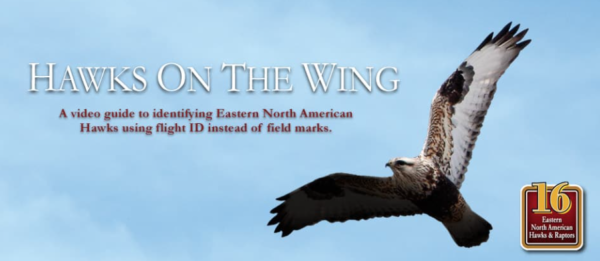
“My goal is to make hawks accessible to everyone and bring common sense techniques to all that want to conquer identification in flight.” -Josh
Hawks on the Wing is an educational video that describes hawk identification painlessly and effectively by Michigan’s own Josh Haas! I highly recommend this for any and all levels. It is a DVD I continually return to in my work. The side-by-side video comparisons are just as realistic and helpful as raptor ID can get! Josh’s video is available on DVD, Blu-ray, and digital download. There might even be an October coupon code, so check it out while fall migration is still hopping! Josh’s site is a great foundation for launching even farther into the happiness of hawks. Michigan Audubon chapters: note that Josh often books speaking engagements as a professional photographer, birder, and seasoned hawkwatcher! He’s a great friend of Michigan Audubon and an engaged ambassador for hawk appreciation and conservation.
Find live hawk count data on Dunkadoo, an app that helps scientists, field staff, volunteers, and more collect data in the field. This tool has been extremely helpful for the spring hawk count conducted at Whitefish Point Bird Observatory.
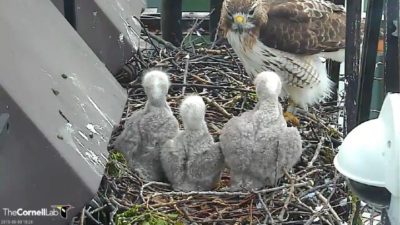
Cornell Lab’s Red-tailed Hawks NestCam provides a live look as new broods are reared each breeding season.
